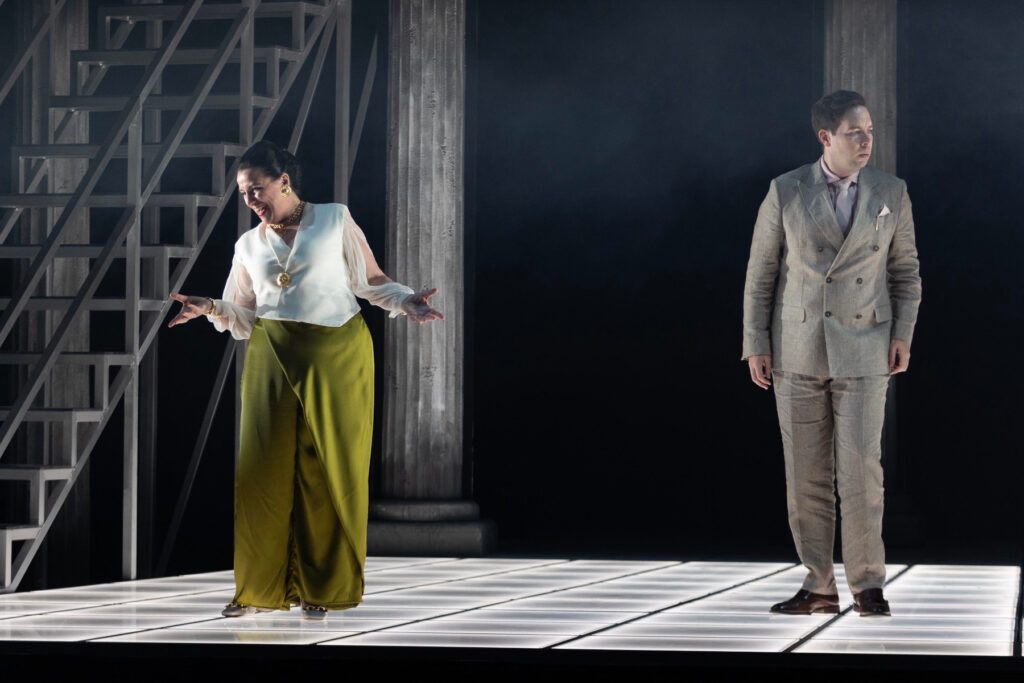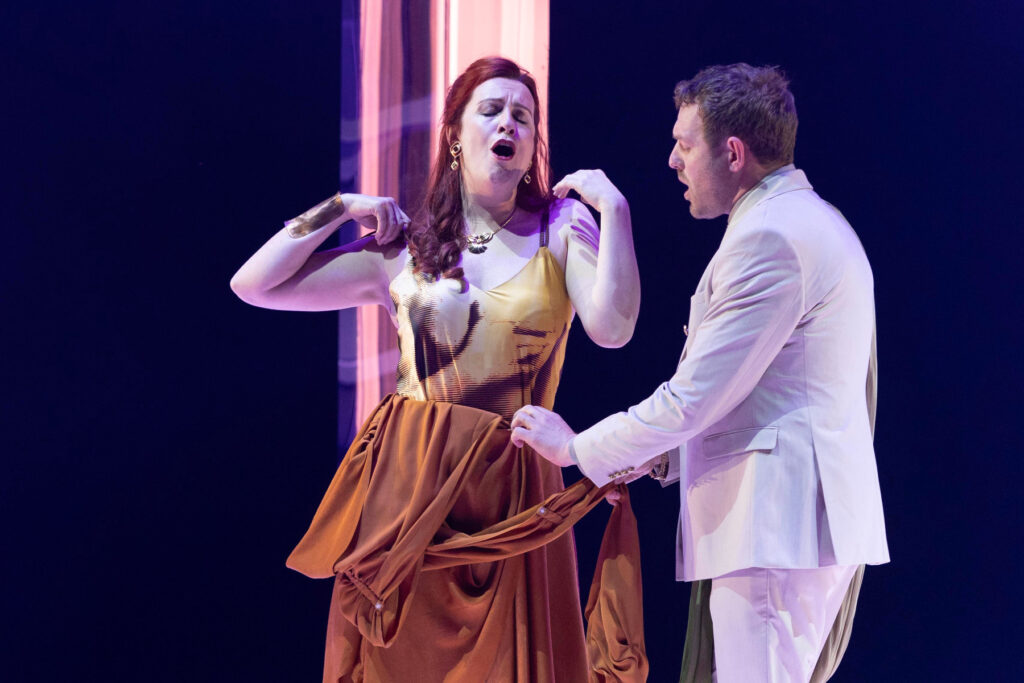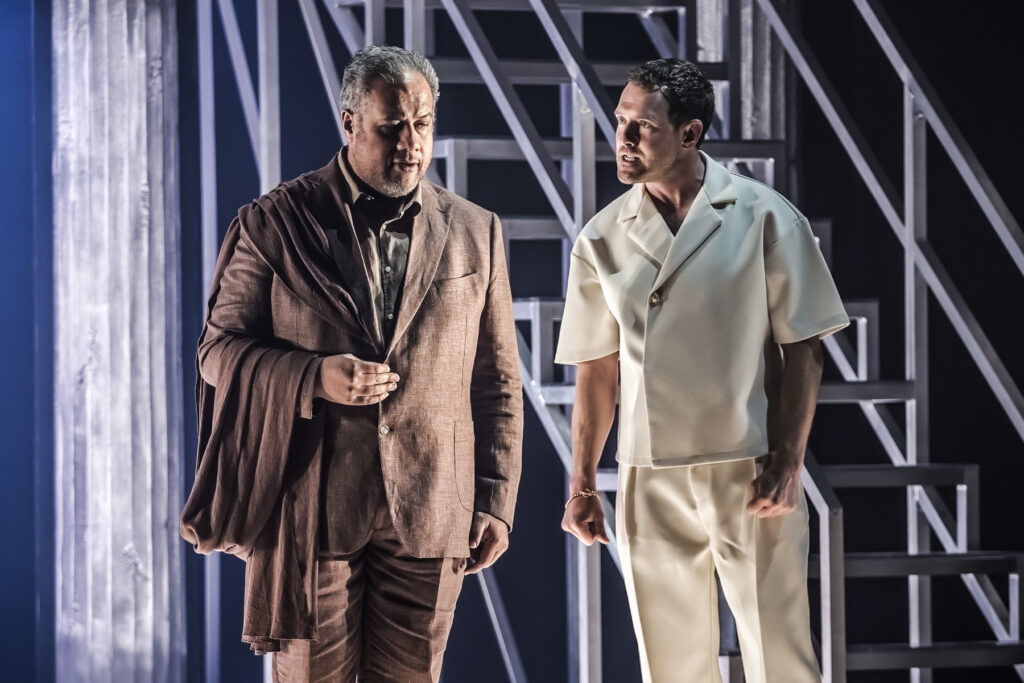Having presented Handel’s Agrippina in 2018 – wittily reinterpreting Nero’s accession to power as the Grange Festival’s assumption of the role of company in residence at the Grange, Northington, after the departure of Grange Park Opera following the 2016 season – director Walter Sutcliffe and designer Jon Bausor now offer an equally enthralling account of Monteverdi’s opera (1642) about a later episode in Nero’s reign. Although there are jokes and satire, it’s a generally more serious affair than their earlier effort, though no less incisive for that. It reminds us that what we know about Nero comes from historical accounts (e.g. by Tacitus and Suetonius) with their own biases and perspectives on events that were, for them, some time past (as those who saw the exhibition about the emperor at the British Museum in 2021 will readily appreciate, as well as viewers or readers of I, Claudius, where Nero appears in the later stages as Claudius’s adopted heir).

Furthermore, just as Monteverdi and his superb librettist Giovanni Francesco Busenello were concerned with creating a drama that engaged with the prevailing intellectual and political ideas of their day in the later Renaissance period, Sutcliffe posits one such topic as a possible means of assessing Nero’s personality and rule. At the beginning, a quotation from Machiavelli (Discourses on Livy I think, rather than The Prince) is beamed on to the set, about how a prince must cultivate the art of war with ‘virtù’ (a much more vital moral category in Renaissance Italian philosophical thought than our mealy, prissy English term ‘virtue’ might suggest), and that it was the lack of this quality which caused the Roman Empire to decline. That pre-empts the debate between the divine incarnations of Virtue and Fortune in the Prologue as to which of them holds sway over humankind, to be laughed off in turn by Love. Subsequent assessments of character and circumstance are offered, as a couple of Seneca’s maxims on stoicism are quoted during his death scene, and at the end of the opera the consummation of Nero and Poppea’s infatuation during ‘Pur ti miro’ is accompanied by the narration of the emperor’s inglorious death (and as though this is read from a book by Ottavia, Nero’s estranged wife).
Sutcliffe’s production is tellingly structured so that Seneca is as much of a presence as Nero or Poppea, the drama pivoted upon his death which falls as the climax of the first half before the interval, although it occurs a little way into Act Two in the original text. That first half is deliberately stiff and formal, the series of confrontations or encounters between pairs of characters in dialogue and the various sustained monologues both creating a palpable tension and the sense of a stern moral authority hovering over their actions. In the second half after Seneca’s death, there’s a loosening up as though that patriarchal control has been lifted so that pleasure may reign and the world is almost turned upside down. Nero snorts drugs with the poet Lucano and they briefly linger in a near embrace with each other; Poppea achieves her elevation as the empress at the same time as her nurse congratulates herself on becoming a lady; and Poppea and Drusilla (the lover of Poppea’s previous inamorato, Ottone) separately cavort on a bed which is made upon the marble basin in which Seneca had met his end.

Like his production of Agrippina, Sutcliffe keeps the retelling vaguely local in that the action occurs within a courtyard bounded on three sides by colonnades of Greek (rather than Roman) columns – presumably in deference to the Greek Revivalism of the Grange; and the goddess Fortune’s coming on to the stage from the auditorium during the Prologue immerses us within that courtyard, implying the missing fourth colonnade or theatrical wall behind us. The characters are dressed in contemporary costume (with the odd nod to Classical attire) making it overtly a drama played out in our time, for us to interpret as we will.
The cast are excellently attuned to the pace and temper of the drama and, alongside the musical support of David Bates and La Nuova Musica in the pit, are wonderfully able in sustaining urgency and tension across a whole scene, rather than merely issuing well-turned phrases in unconnected succession. Kitty Whately charms Nero and us with her cool, collected portrayal of Poppea, working her ambition with quiet concentration, compared with which Sam Furness’s Nero draws a conspicuous contrast as though distracted or possessed – by uncertainty and fear in the first part while still under Seneca’s influence, and then by frenzy and ecstasy in the second, all the while maintaining firm musical control. Christopher Lowrey sounds rightly feckless as Ottone, Poppea’s jilted lover, until it strikes one that, amidst all the shenanigans, he evinces a sober but expressive constancy and dedication to his new lover Drusilla. That is complemented by the colour, even flirtatiousness, of Vanessa Waldhart’s performance in the latter role, as also in her impersonation of Love, drawing a telling picture of what romantic fidelity might be, compared with Nero and Poppea’s emotional volatility.

Anna Bonitatibus gives a searing account of Ottavia without histrionics, while Jonathan Lemalu is an unruffled Seneca, benignly sonorous rather than stentorian. Initially it seems disappointing that neither of the two nurses are taken as male roles in drag, as they often are, in keeping with the ribald tradition of Venetian opera. But it proves better in the context of this production that they are not turned into slapstick distractions – Fiona Kimm’s artfully husky delivery as Ottavia’s aged nurse, and Frances Gregory’s excitable Arnalta (Poppea’s nurse) capably make the comic point without resort to caricature.
Bates draws a remarkable array of sonorities from his ensemble: to watch him in the pit is to see a craftsman in action, sometimes attending to his own playing at the harpsichord or to directing the instrumentalists around him, at others flinging his arms upwards to impel the singers on stage to the next dramatic shift in mood or pace. But that is all pressed into the service of a consistent intensity which accumulates during the course of each scene and Acts. This is a gripping and even, at times, disturbing account of Monteverdi’s masterpiece, adopting a high moral and dramatic seriousness with respect to all aspects of its music and libretto, that illuminate the nature of power in our time (not least during a general election) as much as in the Roman period or the 17th century – very truly a five star production, and easily one of the best interpretations of Monteverdi or a Baroque opera I have seen.
Curtis Rogers
L’incoronazione di Poppea
Composer: Claudio Monteverdi
Libretto: Giovanni Francesco Busenello
Poppea / Fortuna – Kitty Whately; Drusilla / Amore – Vanessa Waldhart; Ottavia / Virtu – Anna Bonitatibus; Ottone – Christopher Lowrey; Nerone – Sam Furness; Seneca – Jonathan Lemalu; Arnalta / Famigliari 1 – Frances Gregory; Nutrice – Fiona Kimm; Soldato 1 / Lucano / Famigliari 2 – Gwilym Bowen; Soldato 2 / Liberto – Jorge Navarro Colorado; Famigliari 3 – Armand Rabot
Director – Walter Sutcliffe; Designer – Jon Bausor; Lighting Designer – Peter Mumford; La Nuova Musica, Conductor – David Bates
The Grange, Northington, Alresford, Hampshire, 14 June 2024
Top Image: Vanessa Waldhart (Drusilla/Amore)
All photos © Craig Fuller